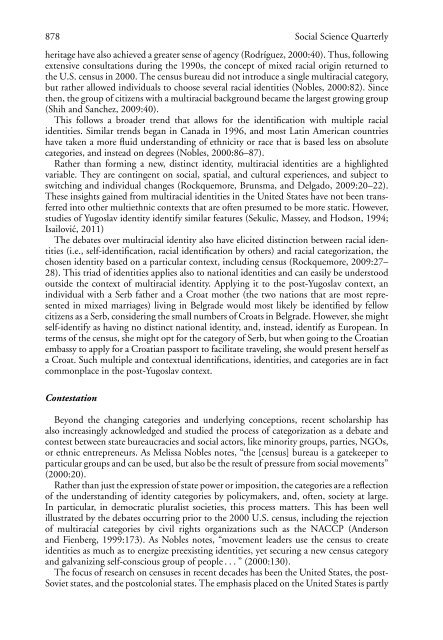The Construction of National Identity and its Challenges in Post-Yugoslav Censuses
Create successful ePaper yourself
Turn your PDF publications into a flip-book with our unique Google optimized e-Paper software.
878 Social Science Quarterly<br />
heritage have also achieved a greater sense <strong>of</strong> agency (Rodríguez, 2000:40). Thus, follow<strong>in</strong>g<br />
extensive consultations dur<strong>in</strong>g the 1990s, the concept <strong>of</strong> mixed racial orig<strong>in</strong> returned to<br />
the U.S. census <strong>in</strong> 2000. <strong>The</strong> census bureau did not <strong>in</strong>troduce a s<strong>in</strong>gle multiracial category,<br />
but rather allowed <strong>in</strong>dividuals to choose several racial identities (Nobles, 2000:82). S<strong>in</strong>ce<br />
then, the group <strong>of</strong> citizens with a multiracial background became the largest grow<strong>in</strong>g group<br />
(Shih <strong>and</strong> Sanchez, 2009:40).<br />
This follows a broader trend that allows for the identification with multiple racial<br />
identities. Similar trends began <strong>in</strong> Canada <strong>in</strong> 1996, <strong>and</strong> most Lat<strong>in</strong> American countries<br />
have taken a more fluid underst<strong>and</strong><strong>in</strong>g <strong>of</strong> ethnicity or race that is based less on absolute<br />
categories, <strong>and</strong> <strong>in</strong>stead on degrees (Nobles, 2000:86–87).<br />
Rather than form<strong>in</strong>g a new, dist<strong>in</strong>ct identity, multiracial identities are a highlighted<br />
variable. <strong>The</strong>y are cont<strong>in</strong>gent on social, spatial, <strong>and</strong> cultural experiences, <strong>and</strong> subject to<br />
switch<strong>in</strong>g <strong>and</strong> <strong>in</strong>dividual changes (Rockquemore, Brunsma, <strong>and</strong> Delgado, 2009:20–22).<br />
<strong>The</strong>se <strong>in</strong>sights ga<strong>in</strong>ed from multiracial identities <strong>in</strong> the United States have not been transferred<br />
<strong>in</strong>to other multiethnic contexts that are <strong>of</strong>ten presumed to be more static. However,<br />
studies <strong>of</strong> <strong>Yugoslav</strong> identity identify similar features (Sekulic, Massey, <strong>and</strong> Hodson, 1994;<br />
Isailović, 2011)<br />
<strong>The</strong> debates over multiracial identity also have elicited dist<strong>in</strong>ction between racial identities<br />
(i.e., self-identification, racial identification by others) <strong>and</strong> racial categorization, the<br />
chosen identity based on a particular context, <strong>in</strong>clud<strong>in</strong>g census (Rockquemore, 2009:27–<br />
28). This triad <strong>of</strong> identities applies also to national identities <strong>and</strong> can easily be understood<br />
outside the context <strong>of</strong> multiracial identity. Apply<strong>in</strong>g it to the post-<strong>Yugoslav</strong> context, an<br />
<strong>in</strong>dividual with a Serb father <strong>and</strong> a Croat mother (the two nations that are most represented<br />
<strong>in</strong> mixed marriages) liv<strong>in</strong>g <strong>in</strong> Belgrade would most likely be identified by fellow<br />
citizens as a Serb, consider<strong>in</strong>g the small numbers <strong>of</strong> Croats <strong>in</strong> Belgrade. However, she might<br />
self-identify as hav<strong>in</strong>g no dist<strong>in</strong>ct national identity, <strong>and</strong>, <strong>in</strong>stead, identify as European. In<br />
terms <strong>of</strong> the census, she might opt for the category <strong>of</strong> Serb, but when go<strong>in</strong>g to the Croatian<br />
embassy to apply for a Croatian passport to facilitate travel<strong>in</strong>g, she would present herself as<br />
a Croat. Such multiple <strong>and</strong> contextual identifications, identities, <strong>and</strong> categories are <strong>in</strong> fact<br />
commonplace <strong>in</strong> the post-<strong>Yugoslav</strong> context.<br />
Contestation<br />
Beyond the chang<strong>in</strong>g categories <strong>and</strong> underly<strong>in</strong>g conceptions, recent scholarship has<br />
also <strong>in</strong>creas<strong>in</strong>gly acknowledged <strong>and</strong> studied the process <strong>of</strong> categorization as a debate <strong>and</strong><br />
contest between state bureaucracies <strong>and</strong> social actors, like m<strong>in</strong>ority groups, parties, NGOs,<br />
or ethnic entrepreneurs. As Melissa Nobles notes, “the [census] bureau is a gatekeeper to<br />
particular groups <strong>and</strong> can be used, but also be the result <strong>of</strong> pressure from social movements”<br />
(2000:20).<br />
Rather than just the expression <strong>of</strong> state power or imposition, the categories are a reflection<br />
<strong>of</strong> the underst<strong>and</strong><strong>in</strong>g <strong>of</strong> identity categories by policymakers, <strong>and</strong>, <strong>of</strong>ten, society at large.<br />
In particular, <strong>in</strong> democratic pluralist societies, this process matters. This has been well<br />
illustrated by the debates occurr<strong>in</strong>g prior to the 2000 U.S. census, <strong>in</strong>clud<strong>in</strong>g the rejection<br />
<strong>of</strong> multiracial categories by civil rights organizations such as the NACCP (Anderson<br />
<strong>and</strong> Fienberg, 1999:173). As Nobles notes, “movement leaders use the census to create<br />
identities as much as to energize preexist<strong>in</strong>g identities, yet secur<strong>in</strong>g a new census category<br />
<strong>and</strong> galvaniz<strong>in</strong>g self-conscious group <strong>of</strong> people . . . ” (2000:130).<br />
<strong>The</strong> focus <strong>of</strong> research on censuses <strong>in</strong> recent decades has been the United States, the post-<br />
Soviet states, <strong>and</strong> the postcolonial states. <strong>The</strong> emphasis placed on the United States is partly
















